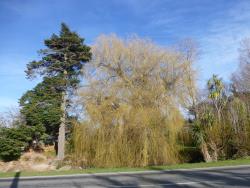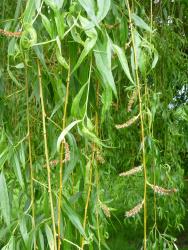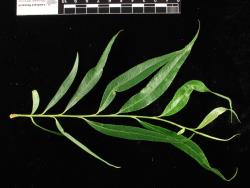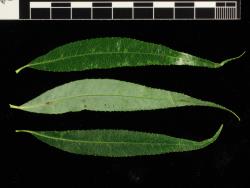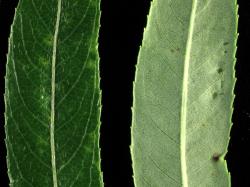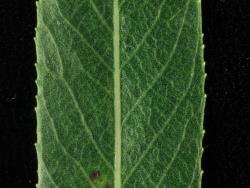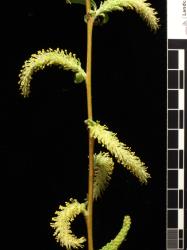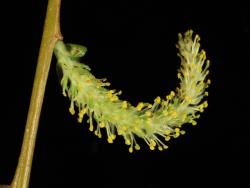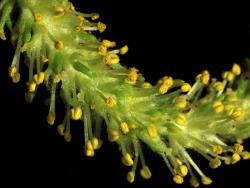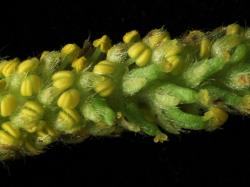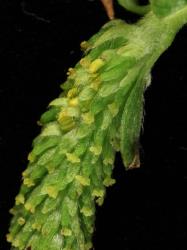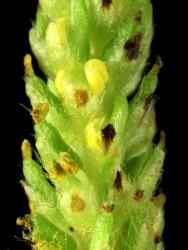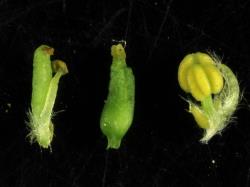- ≡ Salix babylonica var. salamonii Carrière, Hort. Franc. 1864: 339 (1864) – as [infrasp. unranked] Salamonii
- ≡ Salix ×salamonii (Carrière) Carrière, Rev. Hort. (Paris) 41: 463 (1869) – as Salix Salamonii
- = Salix alba var. vitellina-tristis Ser., Essai Saules Suisse 83 (1815)
- ≡ Salix ×chrysocoma Dode, Bull. Soc. Bot. France 55: 655-656 (1909)
- ≡ Salix ×sepulcralis var. chrysocoma (Dode) Meikle, Watsonia 15: 274 (1985) – as nothovar. chrysocoma
- = Salix ×salamonii 'Chyrsocoma'
Branchlets weeping, unbranched terminal portion up to 1 m long. Current year's branchlets sparsely short-silky hairy, hairs not persisting; mid-yellow. Year-old branchlets mid- to deep yellow (UCL85–87), 1.6–2.5 mm diameter. Flower bud scales 9–11 mm long, 3.0–4.5 mm wide, 2.4–3.0 mm deep, ovoid, with 2 lateral keels, strong yellow (UCL84), sparsely long-silky hairy. Stipule not persisting, 3–5 mm long, very narrowly ovate, toothed or entire, apex acute. Emerging leaves usually green, rarely tinged with orange. Leaf lamina 111–155 mm long, 16–34 mm wide, not falcate; base cuneate; upper leaf surface with dense stomata. Catkins androgynous. Flowering branch 28–55 mm long, with 6–11 leaves. Predominantly male catkins, when present, 27–49 mm long, 7–9 mm diameter; catkin rachis visible between flowers. Flower bract 1.8–2.8 mm long, 0.6–0.75 mm wide, pale green, sometimes with a brown apical spot, narrowly ovate; female bract not persistent. Male nectaries 2, 0.6–0.7 mm long, 0.4 mm diameter, cylindrical, yellow. Stamens 2, filaments free or joined at the base, hairs present on lower half; anther 0.9–1.1 mm long, yellow. Female nectary 0.4–0.5 mm long, 0.3–0.4 mm wide.
A very common weeping willow, mostly planted on river and stream banks, but not exclusively so, it can also be seen planted on well-drained soils. It is as common in New Zealand as f. pendulina. A tree with yellow, pendulous 1–2 year-old branchlets (pendulous branchlets are not conspicuous in young plants). Catkins are predominantly either male or female with some flowers of the other sex, and entirely female catkins occur on trees with androgynous catkins. Individual flowers may be teratological, with a stamen + ovary or 2 stamens + ovary, sometimes with an anther immersed within the ovary. The flower scale often develops a brown spot at the apex. Stomata on the upper leaf surface are dense. The ovary is sessile and widest at the base; the style arms are short. Emerging leaves have dense long-silky hairs that do not persist.
Most similar to Salix ×pendulina f. pendulina, weeping willow. Both have long-hanging branchlets that hang to ground or water level and are unbranched for the terminal metre or more. Forma pendulina is always female in New Zealand and catkins are never mixed in their sexuality, as is always the case in f. salamonii; f. pendulina has one-year-old branchlets that are olive in colour, rather than mid- to deep yellow in f. salamonii. Stomata are dense over the upper leaf surface, while in f. pendulina they are dense only near the midvein. Leaf galls occur on f. salamonii leaves but not on f. pendulina leaves. Infection by leaf rust in late summer is a feature of f. pendulina, but not of f. salamonii.
Also similar in branchlet colour to Salix ×fragilis f. vitellina, but that hybrid does not have such obviously hanging branchlets. Ovaries in S. ×fragilis f. vitellina do not swell at the base and do not mature into capsules, while in S. ×pendulina f. salamonii, as with all other tree willows, ovaries swell at the base and mature to capsules. Female flower bracts in f. salamonii are short: 1.8–2.8 mm long, while in S. ×fragilis f. vitellina they are exceptionally long: 3.0–4.0 mm long.
Taranaki (Whanganui 2012), Canterbury (Kaiapoi 1964, Southbrook 1964, Rangitata River 1964, Arowhenua 1964), Otago (Lake Hawea 1986, Alexandra 1966), Fiordland (Te Anau 1977).
First collection: CHR 193576, A. J. Healy 66/482, 17 October 1966, Otago, above Alexandra, "swamp".
First publication: Sykes (1982) as Salix ×chrysocoma.
Flowering: Early September–late September.
Provisionally tetraploid, based on a flow cytometry result using PN248.



